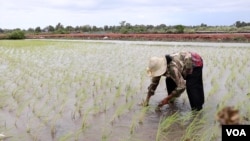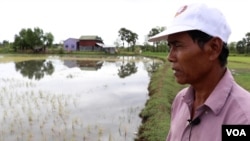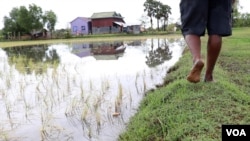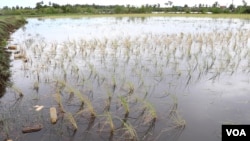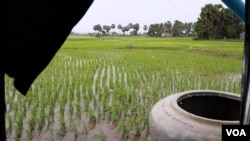Prak Nhorn has no hope for his rice crop this year.
“When I transplant seedlings, they die out. The salt is still in the soil,” said the farmer from Slab Ta Aon village, a riverside settlement roughly 150 kilometers southwest of Cambodia’s capital, Phnom Penh, and 4 kilometers from the green, mangrove-lined coast of Kampot province.
The farmer said that saltwater has destroyed rice paddies in Slab Ta Aon village for the past two years. Prak Nhorn, 55, doubts that he and the other villagers will be able grow rice in the future.
Slab Ta Aon’s problem is no environmental fluke. It is an omen of a global environmental crisis that has been brewing for decades, destabilizing food systems that feed millions.
Around the world, saltwater is seeping further and further inland from the coasts, tainting soils and fresh water with salt. A complicated interplay between groundwater extraction, river damming for hydropower, and riverbed mining is sinking shorelines as climate change raises the seas, drawing seawater inland.
River deltas are especially vulnerable. Fan-shaped plains that form where rivers spill into the sea, deltas often boast fertile soils thanks to nutrient-rich sediments delivered from upstream. Increasing salinity puts these special agricultural regions at risk.
The threat is perhaps most grave in Asia, where vast “megadeltas” are vital for growing the continent’s staple crop — rice. High salinity can make it impossible to grow rice.
“You really see a solid layer … a white layer on the soil from where saltwater was,” said Bjoern Ole Sander of the International Rice Research Institute (IRRI). Rice plants growing in saline soil “look like straw,” he continued. “If you touch them, they’re hollow. There’s nothing.”
Food, drinking water at risk
In Southeast Asia, saltwater threatens rice paddies in the Mekong River and Red River deltas in Vietnam, and the deltas of the Chao Phraya River in Thailand, and the Ayeyarwady River in Myanmar.
In South Asia, it degrades soils and taints drinking water in the densely populated Ganges–Brahmaputra Delta of Bangladesh and India and the Indus Delta of Pakistan.
China’s Yangtze River Delta also faces rising salinity.
Beyond Asia, saltwater intrusion affects the Nile Delta in Egypt and the Mississippi Delta in the United States — both important agricultural regions.
For subsistence farmers like Prak Nhorn, rising salinity directly threatens food security and access to drinking water. About 76% of Cambodians live in rural areas and many depend on natural resources for food. This makes many of the country’s 17.2 million inhabitants vulnerable to changes in the environment. Undernutrition rates in Cambodia hover around 15%.
Cambodian farmers have reported issues with salinity for years and “there is saltwater intrusion” in the country, said Hak Mao, director of Cambodia’s Climate Change Department at the Ministry of Environment. But “limited technical capacity” means the true extent of the problem in Cambodia is not known, he said.
In neighboring Vietnam, however, the costs of saltwater intrusion have been clear for decades.
“If there’s fresh water, we can grow rice all year round,” said farmer Khau Van Ngoan of Vietnam’s Long An province. “If there’s none, nothing can be grown.”
Vietnam grows more than half of its rice in one region — the Mekong River Delta.
There, salinity has “really been on the rise,” said hydrologist Gijs Simons of FutureWater, a consultancy that uses satellite data to assess salinity for the Mekong River Commission (MCR). The area affected by severe salinity, which makes it nearly impossible to grow rice, has roughly “doubled since the '90s or even almost tripled for some years,” he said.
In the past, saltwater would seep about 30-50 kilometers inland. Now it can reach areas more than 100 kilometers inward from the coast, said hydrologist Binh Doan Van of the Vietnamese-German University, who studies saltwater intrusions in the Mekong River Delta. One particularly severe salinity intrusion in 2016 affected 270,000 hectares of rice, said Andrew Wyatt, who oversees projects in Southeast Asia for the environmental organization International Union for Conservation of Nature, or IUCN. The damage totaled an estimated $455 million, or 1.5% percent of Vietnam’s annual rice yield.
Shrimp alternative
But it’s possible to see rising salinity as an opportunity rather than a disaster.
Rice can’t tolerate salty water, but shrimp can — and shrimp fetch a better price than the rice Vietnam produces for export to low- and middle-income countries.
“Shrimp is better business than rice. It’s more lucrative,” said Dang Thi Vich, a shrimp farmer from Ben Tre province.
Some farmers in the Mekong River Delta took advantage of this as salinity rose, growing shrimp instead of rice during the dry season when conditions are most saline. The Vietnamese government and NGOs later launched programs to help more farmers adopt this rice-shrimp rotation system.
“Shrimp farming began about some 20 years ago and it’s become very popular,” said Vich. “Everyone grew rice before that.”
Things are changing fast. In 2018, 15% of farmers in the delta gave up rice farming for something else, usually shrimp farming, said Bradford Mills, an economist at Virginia Tech who studied the switch. The next year, another 10% stopped growing rice. Simons noted that the shift from rice paddies to shrimp ponds is visible in his satellite data.
Experts say the Vietnamese government plans to scale back rice farming and diversify the Mekong River Delta’s economy. This will mean upping shrimp and other aquaculture along the coast and growing “high quality” rice for export to rich countries. This diversification “is in line with Vietnam's move from a low-income country to a middle-low-income country,” said Wyatt.
But researchers have expressed concerns that adaptions to rising salinity in Vietnam are coming at a social cost, widening the gap between rich and poor.
“For the country scale, [shrimp farming] may be good,” said Binh. “But for [the] local scale, for individuals, that's I think [it] still has some problems.”
Ben Tre province farmer Nguyen Thi Be Lieu said she tried shrimp farming a couple of years ago, “but business didn’t take off. We spent more than we earned, so we stopped.”
Switching from rice to shrimp aquaculture is risky. Not everyone can afford to. Those who can’t — and who don’t receive aid — can have no choice but to sell or lease their land and migrate to find work.
There’s also evidence that shrimp aquaculture isn’t always environmentally sustainable. While Wyatt noted that rice-shrimp rotation is more sustainable than farming rice or shrimp exclusively for lands at the mouth of the Mekong, it isn’t a good solution everywhere it is being adopted. If there’s not enough freshwater flow from upstream, dry-season shrimp ponds can leave salt in the soil, which over time makes it hard to grow rice at all in the wet season. Ponds can get so salty that even shrimp can’t survive.
“Saline soil is bad for business, even shrimp farming,” said Long An province farmer Pham Van Bay. “There’s absolutely nothing you can do with saline soil.”
Aquaculture can also pollute waterways, a problem Binh says should be managed to ensure that it stays sustainable and profitable for the future.
Still, if these challenges can be overcome, sating wealthy countries’ appetites for shrimp and high-quality rice could pay off for many farmers and the Vietnamese economy as a whole, said Binh and Wyatt.
‘How can we have rice to eat?’
The question, said Sander, “is of course: where do you produce the rice instead? Because demand is still there. And shrimp cannot replace rice on people's plates.”
Vietnam is the third-biggest rice exporter worldwide, and more than 90% of its exports come from the Mekong River Delta. Countries that are “big rice importers … are hit also by climate change impacts and salinity impacts in the Mekong Delta,” said Sander. For instance, the Philippines imports nearly 80% of its rice from Vietnam.
Demand for rice is increasing as the world population grows. IRRI estimates that rice production globally needs to increase by 1% to 1.2% every year to keep rice prices low enough to be affordable for billions of people who depend on the grain.
For the Mekong River Delta, Binh said that adapting to rising salinity involves a combination of pricey infrastructure to keep saltwater out — which can come with its own environmental problems — and changes to how people live and work, like adopting rice-shrimp systems. Other agricultural deltas face similar choices.
Countries that import a lot of rice from salinity-affected regions will need to find new sources to meet their growing demand for rice, or consumers will simply pay more for it. Many farmers will need to adapt. And some will just need to find a way to survive.
Suos Sovann lives just a stone’s throw away from Prak Nhorn’s farm in Slab Ta Aon village. She is a rice farmer — or was. Saltwater now floods her 7,000-square-meter farm every year, making her soil infertile.
Unable to grow rice for herself and her family, Suos Sovann now depends on money sent by two of her children who work in a nearby garment factory. Combined, they send her about $50 every month. She will spend $30 of it on rice.
She wonders if perhaps her children could send more money, but she doesn’t dare ask. There’s nothing to do but bear with it, she says.
"If we don’t farm," asked Suos Sovann, "how can we have rice to eat?”
The Vietnamese journalist who contributed to this report is not named for their safety.
